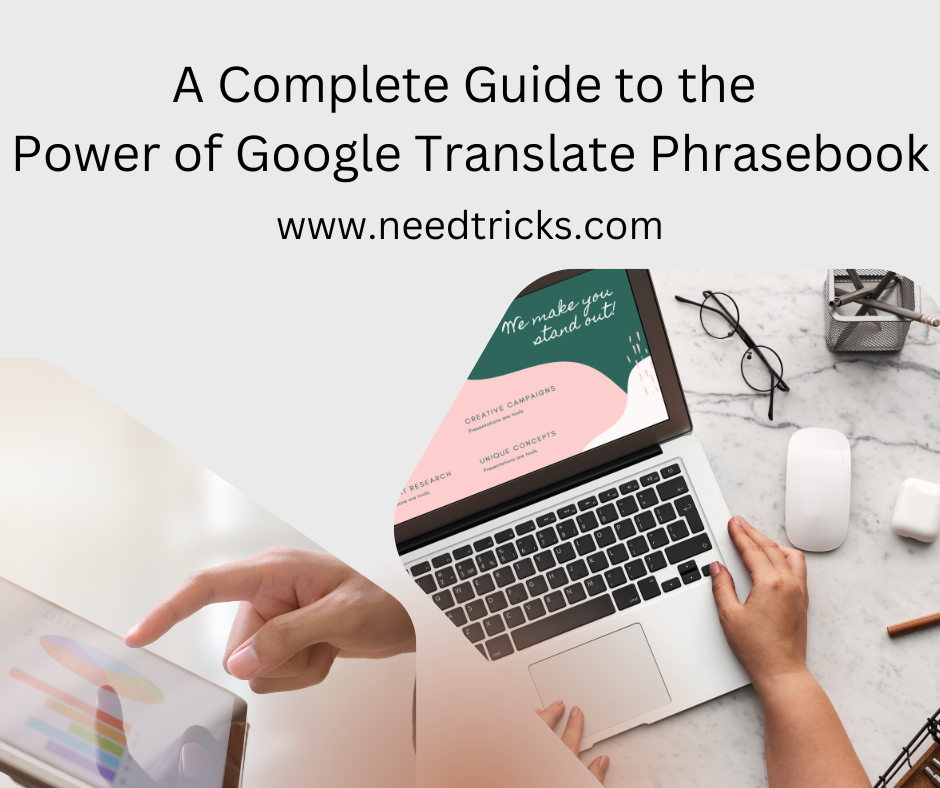The Google Translate Phrasebook is a versatile and powerful tool that can benefit language learners, travelers, and anyone looking to overcome language barriers. Google Translate has been a game-changer in breaking down these barriers. Among its many features, the Google Translate Phrasebook stands out as a powerful tool for language learners, travelers, and anyone seeking to bridge linguistic gaps (Power of Google Translate Phrasebook).
A Complete Guide to the Power of Google Translate Phrasebook
In this comprehensive guide, we will delve into the world of Google Translate Phrasebook, exploring how to add phrases, its key features, and how it can enhance your language learning and communication experiences.
Getting Started with Google Translate
Google Translate is a free online service and a mobile app developed by Google that offers translation between languages. With its user-friendly interface and advanced translation capabilities, it’s an indispensable tool for anyone dealing with foreign languages. Before we dive into the details of the Google Translate Phrasebook, let’s start by understanding how to use Google Translate and how it can benefit you.
1. Using Google Translate for Text Translation
- Visit the Google Translate website or open the mobile app.
- Select the languages you want to translate from and into.
- Type or paste the text you want to translate into the provided box.
- Click the “Translate” button, and voila! You have your translation.
2. Google Translate App
- Download and install the Google Translate app from your device’s app store.
- Open the app and choose your preferred languages.
- Use your device’s camera to translate text from images, or use the microphone for voice translations.
- The app also allows you to download languages for offline use, which can be handy while traveling.
Exploring the Google Translate Phrasebook:
Now that we have a basic understanding of Google Translate, let’s delve into the heart of our discussion: the Google Translate phrasebook.
1. What is the Google Translate Phrasebook?
- The Google Translate Phrasebook is a feature within Google Translate that allows you to save and organize your favorite translations and phrases.
- It serves as a personal language reference library, making it easier to access and reuse translations, even when you’re offline.
2. Key Benefits of Using the Google Translate Phrasebook
- Convenient Access: Your saved phrases are just a few taps away, eliminating the need to retype or search for translations repeatedly.
- Offline Use: You can access your phrasebook even without an internet connection, making it ideal for travelers.
- Language Learning: It’s a valuable tool for language learners, enabling them to build a customized vocabulary list.
- Improved Communication: Instantly retrieve and share important phrases in a foreign language.
Adding Phrases to Your Google Translate Phrasebook:
The Google Translate Phrasebook becomes truly valuable when you populate it with useful phrases. In this chapter, we’ll explore how to add phrases to your phrasebook.
1. Adding phrases from text translation
- Translate a phrase as you normally would using Google Translate.
- After translation, click on the star icon next to the translated phrase to add it to your phrasebook.
- You can categorize phrases into folders, making it easier to organize and find them later.
2. Manually Adding Phrases
You can also manually add phrases to your phrasebook without translating them first.
- Open the Phrasebook tab in the Google Translate app or website.
- Click on the “+” or “Add a phrase” button.
- Enter the phrase you want to save and specify the source and target languages.
- Optionally, add a category or label to help you organize your phrases.
- Managing Your Google Translate Phrasebook:
- As your phrasebook grows, it’s essential to know how to manage and organize your saved phrases effectively.
1. Organizing Phrases with Categories
Categories help you group related phrases together.
- You can create custom categories such as “Travel,” “Business,” or “Personal.”
- Assign each saved phrase to a specific category for easy retrieval.
2. Editing and deleting phrases
- To edit a saved phrase, click on it in your phrasebook and make the necessary changes.
- To delete a phrase, click on the three-dot menu next to the phrase and select “Delete.”
3. Exporting Your Phrasebook
- You can export your entire phrasebook as a.csv file, which is compatible with spreadsheet applications.
- This can be useful for creating flashcards or sharing your phrasebook with others.
Leveraging Google Translate Phrasebook for Language Learning:
The Google Translate Phrasebook isn’t just for travelers; it’s a powerful tool for language learners too. Let’s explore how you can use it to enhance your language learning experience.
1. Building Vocabulary Lists
- Create a dedicated folder in your phrasebook for vocabulary building.
- Add new words and phrases you encounter while studying a foreign language.
- Review and practice these phrases regularly to reinforce your learning.
2. Using flashcards
- Export your phrasebook to a spreadsheet and convert it into flashcards.
- Use flashcard apps or platforms like Anki to create interactive language learning cards.
- Incorporate the flashcards into your daily language-learning routine.
3. Practicing Pronunciation
The Google Translate app has a built-in text-to-speech feature.
- Listen to the pronunciation of phrases in your phrasebook to improve your accent and intonation.
Accessing Your Google Translate Phrasebook Offline:
One of the most significant advantages of the Google Translate Phrase-book is its offline accessibility. In this chapter, we’ll explore how to access your phrasebook without an internet connection.
1. Downloading Languages
- Open the Google Translate app.
- Tap on the settings icon (usually represented by a gear or three dots).
- Select “Offline Translation.”
- Choose the languages you want to download for offline use.
- Downloaded languages include your saved phrases from the Phrasebook.
2. Accessing Your Offline Phrasebook
- Even without an internet connection, you can access your saved phrases and translations in the phrasebook.
- This feature is incredibly useful when traveling to areas with limited or no internet connectivity.
Google Translate Phrase-book Tips and Tricks
To get the most out of your Google Translate Phrasebook, consider these tips and tricks.
1. Share Your Phrasebook
- You can share your phrasebook with others by exporting it and sending the.csv file.
- This is handy when collaborating on translations or sharing language resources.
2. Language Detection
- Google Translate can automatically detect the source language when adding phrases manually.
- This saves you the trouble of specifying the source language each time.
3. Backup Your Phrasebook
- To avoid losing your saved phrases, periodically back up your phrasebook.
- You can do this by exporting it to a.csv file and saving it in a secure location.
The Future of Google Translate Phrase-book
As technology evolves, so too will Google Translate and its Phrasebook feature. While we can’t predict the future with certainty, we can speculate on potential developments.
1. Improved Machine Learning
- Google Translate may become even more accurate and nuanced with further advancements in machine learning and artificial intelligence.
- This could lead to better translations and enhanced language learning experiences.
2. Enhanced Language Support
- Google may expand its language support to include more languages and dialects, making the tool even more versatile.
3. Integration with Other Google Services
- Integration with other Google services like Google Classroom or Google Workspace could streamline language learning and communication in educational and professional settings.
By understanding how to add, manage, and leverage your phrasebook effectively, you can enhance your language skills and improve communication in an increasingly interconnected world. As technology continues to advance, we can expect Google Translate and its Phrasebook feature to play an even more significant role in breaking down language barriers and fostering global understanding. So, whether you’re planning a trip abroad or embarking on a language learning journey, don’t forget to make the Google Translate Phrasebook your trusted companion.











